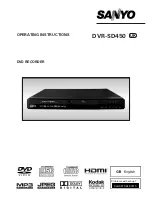
English
Français
Español
EN
– 69 –
Continued on next page.
Glossary
Analog Audio
An electrical signal that directly represents sound. Compare
this to digital audio which can be an electrical signal, but is an
indirect representation of sound. See also “Digital Audio”.
Aspect Ratio
The width of a TV screen relative to its height. Conventional
TVs are 4:3 (in other words, the TV screen is almost square);
widescreen models are 16:9 (the TV screen is almost twice as
wide as it is high).
Chapter (DVD only)
Similar to how a book is split up into several chapters, a title
on a DVD is usually divided into chapters. See also “Title”.
Component Video Output
Each signal of luminance (Y) and component (P
B
/C
B
, P
R
/C
R
)
is independent to output so that you can experience picture
color as it is.
Also, due to compatibility with progressive video (480p), you
can experience a higher-density picture than that in interlace
(480i) mode.
Digital Audio
An indirect representation of sound by numbers. During
recording, the sound is measured at discrete intervals (44,100
times a second for CD audio) by an analog-to-digital converter,
generating a stream of numbers. On playback, a digital-to-
analog converter generates an analog signal based on these
numbers. See also “Sampling Frequency” and “Analog Audio”.
Dolby Digital
The system to compress digital sound developed by Dolby
Laboratories. It offers you sound of stereo(2ch) or multi
channel audio.
Finalize
To make DVDs, which have been recorded on, possible to
play on DVD players. With this unit, it is possible to finalize
DVD-RW, and DVD-R.
HDMI™ (high definition multimedia interface)
A digital interface between audio and video source. It can
transmit component video, audio, and a control signal with
one cable connection.
JPEG (joint photographic experts group)
JPEG is a method of compressing still image files. You can copy
JPEG files to CD-RW/-R or DVD-RW/-R from a computer
and play the files on this unit.
PCM (pulse code modulation)
The most common system of encoding digital audio, found
on CD and DAT. Excellent quality, but requires a lot of data
compared to formats such as Dolby Digital and MPEG audio.
For compatibility with digital audio recorders (CD, MD and
DAT) and AV amplifiers with digital inputs, this unit can
convert Dolby Digital and MPEG audio to PCM. See also
“Digital Audio”.
Progressive Scan (480p)
A type of display that does not split each frame into fields, and
instead scans directly through all the scan lines of each frame
in order. Progressive scan provides less flickering and higher
image resolution than traditional (480i) TV signals. Refer to
page 58 for instructions on selective progressive scan mode.
Region Code
Regions associate discs and players with particular areas of the
world. This unit will only play discs that have compatible region
codes. You can find the region code of your unit by looking on
the rear panel. Some discs are compatible with more than one
region (or all regions).
Sampling Frequency
The rate which sound is measured by a specified interval to
turn into digital audio data. The number of samplings in one
second is defined as sampling frequency. The higher the rate,
the better the sound quality.
S-Video Output
S-video delivers independent signals of color (C) and
luminance (Y) to a TV as video signals, so that a higher-quality
picture will be gained.
Title (DVD only)
A collection of chapters on DVD. See also “Chapter”.
Track
Audio CDs use tracks to divide up the contents of a disc. The
DVD equivalent is called a chapter. See also “Chapter”.
Video mode
Video mode is the same recording format as used on the DVD
videos you purchase in local shops. You can play the discs
recorded in this format in most DVD players, however it offers
only limited editing. You will need to finalize discs recorded in
video mode before playing them back on other units.
VR mode
A basic recording format for DVD-RW. VR mode offers
advanced editing, however it is playable only on VR mode
compatible units. Finalization is recommended before playing
them on other units.




































